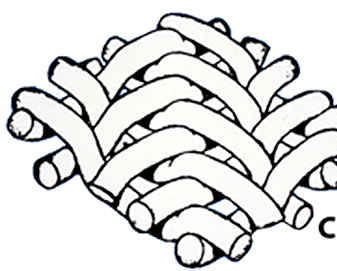Weaves

Plain Weave
Wire cloth woven so that each shute wire passes alternatively under and over successive warp wires and each warp wire passes alternately over and under successive shute wires. Mesh count in warp and shute directions can be different. (Fig. A)

Square Weave
Wire cloth woven with the same diameter warp and shute wires which has equal wire spacing to produce square openings and straight through flow path. (Fig. A)

Dutch Weave
Has fewer and usually heavier diameter warp wires than shute wires. Only because of the crimping of shute wires over and under warp wires is there any open area. In contrast to square weave, the flow path is tortuous. Dutch weave is usually specified to achieve more strength than a square weave with the same particle retention. (Fig. B)

Twilled Dutch Weave
The same as twilled square weave, except that the warp wires are heavier than the shute wires. (Fig. C)

Twilled Square Weave
Wire cloth woven so that each shute wire passes alternately under and over two successive warp wires and each warp wire passes over and under two successive shute wires in a staggered arrangement. It requires less bending of the wires than plain weave, allowing heavier wire for a given mesh that in turn provides greater strength. (Fig. C)





